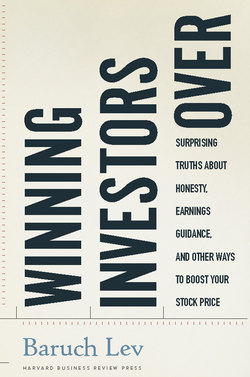Читать книгу Winning Investors Over - Baruch Lev - Страница 4
На сайте Литреса книга снята с продажи.
Ephemeral Growth and Investors’ Discontent
ОглавлениеIt’s all well and good as long as managers report profits and growth—increasing sales, earnings, and margins, beating analysts’ consensus forecasts—and predict a bright future. But practically every growth company sooner or later sees its core businesses mature and ultimately decline, and rejuvenating the growth so craved by investors is difficult. For doubters, the investment research firm Morningstar demonstrates how ephemeral growth is.6 Out of 2,179 public companies that had a one-year rise in earnings-per-share (EPS), only 41 percent saw their EPS increase over three consecutive years, and for five-year running growth, the number dwindles to 16 percent. Only 67 companies of the original 2,179—a mere 3 percent—reported EPS increases for ten years running. These sobering findings concerning the transitory nature of corporate growth are corroborated by comprehensive empirical research.7
The picture is even bleaker for corporate performance tracked by free cash flows (operating cash flows minus capital expenditures). Of the 1,787 companies in Morningstar’s study with a one-year free cash flow growth, only 3 percent managed to report five-year running increases of this widely used performance indicator, and for ten years the number of consistent enhancers of free cash flow is virtually nil. If you wonder why cash-flow growth decays much faster than EPS growth, you will meet a major culprit starring prominently in later chapters—information manipulation. The closely watched EPS figure is manipulated more intensely than are the less scrutinized cash flows, thereby giving the appearance of a longer-lasting EPS growth. By now, the picture should be clear: your likelihood of sooner rather than later disappointing investors with an EPS or cash flow decline or, heaven forbid, a miss of the consensus analyst forecast of earnings is overwhelming.
It happens to the mightiest, too. Consider figure I-1, portraying the number of annual EPS and return on equity (ROE) decreases for Fortune’s ten most-admired companies in 2008, during the fifteen-year period from 1994 to 2008. One would think that “the most admired” don’t disappoint. Far from it. Berkshire Hathaway, Warren Buffett’s famously successful enterprise, had no less than six EPS reversals and seven ROE declines in fifteen years. No wonder Buffett adamantly refuses to provide earnings guidance to investors. Southwest Airlines, the most successful U.S. carrier of all time, experienced no less than five years of disappointing EPS growth and nine reversals of ROE, followed by Procter & Gamble (three and five disappointments) and Toyota (three and six). Apple and Federal Express, celebrated growth stories, also saw their fortunes reverse frequently. Even Google, which enjoyed a meteoric stock price rise from its IPO in 2004 through 2007, has experienced one EPS and five ROE disappointments in its short history.8 Have one last look at the figure and note that, for each company, the number of ROE reversals is substantially larger than EPS decreases. The reason: the closely watched EPS is easier to “manage” than is ROE (by a stock repurchase, for example), and even without manipulation, it often overstates the company’s profitability (since it ignores the capital increase from periodic retained earnings).
Given the overwhelming likelihood of disappointing investors, what’s a manager to do? I devote a considerable part of the book to answer this critical question. From outlining how best to conduct conference calls after disappointing earnings, through immunizing your company against trial lawyers and activist hedge funds preying on companies in distress, to guiding investors on the company’s prospects and providing them with valuation-relevant information not required by accounting rules, I prescribe the ways to avoid capital market setbacks and ride them out when they do occur.
FIGURE I-1
Number of year-to-year decreases of EPS and ROE for the 2008 Fortune most admired companies, 1994–2008
Source: Compustat database.
